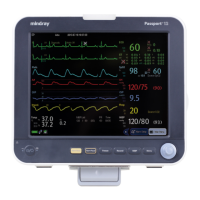3-4 Passport 8/12 Service Manual
IEEE 802.11n (at both 2.4GHz and 5GHz): 6.5 to 72.2 Mbps
Output power
< 30 dBm (FCC requirement: detection mode – peak power)
< 20 dBm (CE requirement: detection mode – RMS)
Operating mode Infrastructure
Data security
Security standards: WPA-PSK, WPA2-PSK, WPA-Enterprise/WPA2-Enterprise
EAP methods: PEAP-MsCHAPv2, PEAP-GTC, PEAP-TLS, EAP-TTLS, EAP-TLS, EAP-FAST,
and EAP-LEAP
Encryption modes: TKIP and AES
Roaming Supported
System capacity
Number of Passport 8/12 monitors supported by a single AP: ≤ 16. Each Passport
8/12 monitor can communicate with the central station and connect to two other
monitors at the same time, and among them, at most two Passport 8/12 monitors
can transmit history data (the Panorama central station does not transfer the
historical data.) when reconnection at the same time. The wireless functions of all
Passport 8/12 monitors are normal at the same time.
Resistance to wireless interference
The wireless functions of the monitor are normal when the following conditions
exist simultaneously:
1. The distance between interfering devices (including wireless devices at the
frequency of 2.4GHz such as cellular communication devices, microwave ovens,
intercoms, cordless phones and electro-surgical units, excluding Wi-Fi) and the
monitor is greater than 20 cm.
2. Co-channel interference (CCI) on the Wi-Fi network should be no greater than
-85dBm.
3. Adjacent–channel interference (ACI) on the Wi-Fi network should be no greater
than -50dBm.
FCC approval SQG-MSD45N
3.2.6 Network Setup Overview
In the [Network Setup] menu, you can set IP address, subnet mask and gateway. You should not change the patient
monitor’s IP address randomly. If you want to know details about IP address setup, contact Mindray Technical Support
Department..
NOTE
The design, installation, restruction and maintenance of the wireless network’s distribution shall be
performed by authorized service personnel of our company.
The existence of obstacles (such as wall) will exert impact on data transferring or even cause network
interruption.
The Central Monitoring System is capable of connecting up to 32 bedside monitors via the wireless network.

